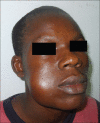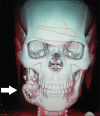Reconstruction of mandibular defects using nonvascularized autogenous bone graft in nigerians
- PMID: 25191100
- PMCID: PMC4141452
- DOI: 10.4103/1117-6806.137309
Reconstruction of mandibular defects using nonvascularized autogenous bone graft in nigerians
Abstract
Objectives: The aim of this study is to evaluate the success rate and complications of mandibular reconstruction with nonvascularized bone graft in Ile-Ife, Nigeria.
Patients and methods: A total of 25 patients who underwent reconstruction of mandibular discontinuity defects between January 2003 and February 2012, at the Obafemi Awolowo University Teaching Hospitals Complex, Ile-Ife constituted the study sample. Relevant information was retrieved from the patients' records. This information include patients' demographics (age and sex) as well as the type of mandibular defect, cause of the defect, type of mandibular resection done, source of the bone graft used, and the method of graft immobilization. Morbidity associated with the graft procedures were assessed by retrieving information on graft failures, length of hospital stay following surgery, rehabilitation device used and associated graft donor and recipient site complications.
Result: There were 12 males and 13 females with a male:female ratio was 1:1.1. The age of the patients ranged from 13 to 73 years with a mean age for males 32.7 ± standard deviation (SD) 12.9 and for females 35.0 ± SD 17.1. Jaw defect was caused by resection for tumours and other jaw pathologies in 92% of cases. Complete symphyseal involvement defect was the most common defect recorded 11 (44%). Reconstruction with nonvascularized rib graft accounted for 68% of cases while iliac crest graft was used in 32% of the patients. Successful take of the grafts was recorded in 22 patients while three cases failed. Wound dehiscence (two patients) and postoperative wound infection (eight patients) were the most common complications recorded.
Conclusion: The use of nonvascularized graft is still relevant in the reconstruction of large mandibular defects caused by surgical ablation of benign conditions in Nigerians. Precise surgical planning and execution, extended antibiotic therapy, and meticulous postoperative care contributed to the good outcome.
Keywords: Mandibular defect; mandibular reconstruction; nonvascularized bone graft.
Conflict of interest statement
Figures






Similar articles
-
Mandibular defect reconstruction with nonvascularized iliac crest bone graft.Niger J Clin Pract. 2012 Apr-Jun;15(2):224-7. doi: 10.4103/1119-3077.97334. Niger J Clin Pract. 2012. PMID: 22718178
-
A comparison of vascularized and nonvascularized bone grafts for reconstruction of mandibular continuity defects.J Oral Maxillofac Surg. 1997 Nov;55(11):1200-6. doi: 10.1016/s0278-2391(97)90165-8. J Oral Maxillofac Surg. 1997. PMID: 9371107
-
Nonvascularized bone grafts for segmental reconstruction of the mandible--a reappraisal.J Oral Maxillofac Surg. 2009 Jul;67(7):1446-52. doi: 10.1016/j.joms.2008.12.052. J Oral Maxillofac Surg. 2009. PMID: 19531416
-
Is immediate reconstruction of the mandible with nonvascularized bone graft following resection of benign pathology a viable treatment option?J Oral Maxillofac Surg. 2015 Mar;73(3):541-9. doi: 10.1016/j.joms.2014.10.019. Epub 2014 Oct 31. J Oral Maxillofac Surg. 2015. PMID: 25683044
-
Mandibular reconstruction using nonvascularized autogenous bone grafting.Curr Opin Otolaryngol Head Neck Surg. 2010 Aug;18(4):227-31. doi: 10.1097/MOO.0b013e32833a46ed. Curr Opin Otolaryngol Head Neck Surg. 2010. PMID: 20508523 Review.
Cited by
-
Mandibular reconstruction using free vascularized iliac crest grafts and dental implants.Clujul Med. 2015;88(3):391-4. doi: 10.15386/cjmed-446. Epub 2015 Jul 1. Clujul Med. 2015. PMID: 26609275 Free PMC article.
-
Reconstruction of a Mandibular Defect with Toronto Bridge Following Tumor Resection and Bone Graft: A Case Report.Front Dent. 2019 Mar-Apr;16(2):153-157. doi: 10.18502/fid.v16i2.1368. Epub 2019 Apr 30. Front Dent. 2019. PMID: 31777858 Free PMC article.
-
Mandibular reconstruction with autogenous non-vascularised bone graft.Afr Health Sci. 2019 Sep;19(3):2768-2777. doi: 10.4314/ahs.v19i3.53. Afr Health Sci. 2019. PMID: 32127850 Free PMC article.
-
Comparison of the Outcome of Free Iliac Bone Graft and Vascularized Iliac Bone Graft in Reconstruction of Mandibular Defects: A Systematic Review.J Maxillofac Oral Surg. 2024 Dec;23(6):1371-1378. doi: 10.1007/s12663-023-02101-4. Epub 2024 Jan 31. J Maxillofac Oral Surg. 2024. PMID: 39618464 Review.
-
Reconstruction of Continuity Defects of the Mandible with Non-vascularized Bone Grafts. Systematic Literature Review.Craniomaxillofac Trauma Reconstr. 2016 Sep;9(3):195-205. doi: 10.1055/s-0036-1572494. Epub 2016 Mar 3. Craniomaxillofac Trauma Reconstr. 2016. PMID: 27516833 Free PMC article. Review.
References
-
- Snyder CC, Bateman JM, Davis CW, Warden GD. Mandibulo-facial restoration with live osteocutaneous flaps. Plast Reconstr Surg. 1970;45:14–9. - PubMed
-
- Strauch B, Bloomberg AE, Lewin ML. An experimental approach to mandibular replacement: Island vascular composite rib grafts. Br J Plast Surg. 1971;24:334–41. - PubMed
-
- Conley J. Use of composite flaps containing bone for major repairs in the head and neck. Plast Reconstr Surg. 1972;49:522–6. - PubMed
-
- Taylor GI, Miller GD, Ham FJ. The free vascularized bone graft. A clinical extension of microvascular techniques. Plast Reconstr Surg. 1975;55:533–44. - PubMed
-
- Goh BT, Lee S, Tideman H, Stoelinga PJ. Mandibular reconstruction in adults: A review. Int J Oral Maxillofac Surg. 2008;37:597–605. - PubMed
LinkOut - more resources
Full Text Sources
Other Literature Sources

